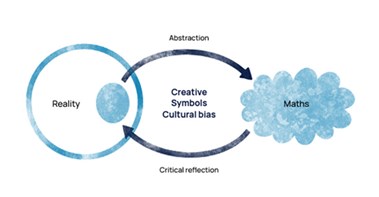Culturally Responsive Pedagogies – Goompi Model

Image: Goompi Model, Professor Chris Matthews, 2009, p. 47
Each of the posters and supporting videos in the Interconnected themes section demonstrates how the Goompi Model of pedagogy could be used in practice.
Matthews' first mathematics education project was at Goompi (Dunwich) State School on Minjerribah (Stradbroke Island), Queensland. 'The model is called the Goompi Model because it is the traditional name of the Country Dunwich State School resides. The name keeps the connection back to Country: its place of origin.'
Reality
Reality is the knowledges that are shared from First Nations perspectives.
In the Reality stage of the Goompi Model, educators share Indigenous Knowledges (IK) with students to build on the cultural wealth of community.
Abstraction
In the Abstraction stage of the Goompi Model, educators abstract the mathematics from Reality.
In each of the film clips, the yellow circle represents the Third Cultural Space. This supports educators to understand mathematics from a different cultural perspective.
Mathematics
Educators use their mathematics content knowledge to relate the mathematics on Country to the Australian Curriculum: Mathematics.
Opportunities are provided for mathematics outdoors and on Country.
Critical reflection
The Critical Reflection stage of the Goompi Model is where students and educators critically reflect on how mathematics and culture are closely linked.
It may relate to:
- testing a theory
- asking community
- writing about your learning.
© 2023 Commonwealth of Australia. These resources may be used under a Creative Commons Attribution-Non Commercial-No Derivatives (CC BY-NC-ND 4.0) licence. These resources were created by Stronger Smarter Institute and Indigenous knowledge-holders.